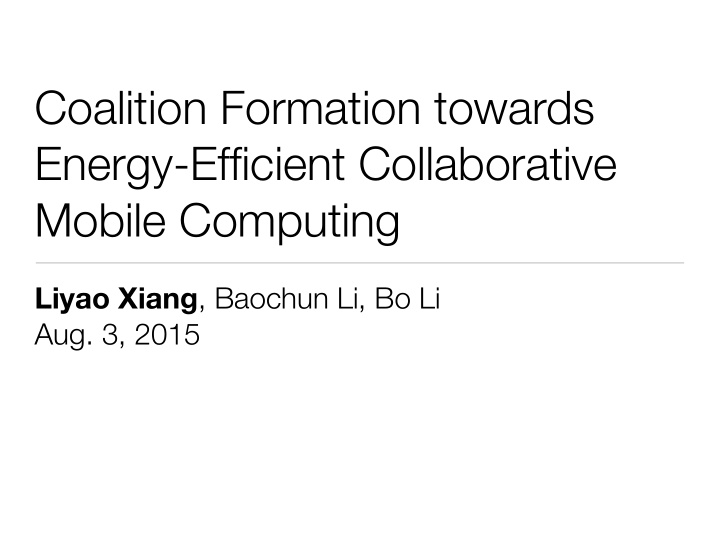



Coalition Formation towards Energy-Efficient Collaborative Mobile Computing Liyao Xiang , Baochun Li, Bo Li Aug. 3, 2015
Collaborative Mobile Computing ‣ Mobile offloading: migrating the computation-intensive portion of an app to the cloud to execute. ‣ Gain: trades the relatively low communication energy expense for high computation power consumption. ‣ Loss: suffers high network latency. ‣ New features such as Continuity made offloading tasks to nearby devices possible. 2
Coalition Formation of Mobile Users ‣ Previous works assume fully cooperative mobile users. ‣ We assume users are: ‣ cooperative: collaborates under agreements. ‣ individually rational: prefers coalition if it benefits. ‣ We study the problem of coalition formation among a group of mobile users targeting at the same job. 3
Coalition Formation of Mobile Users ‣ User case: crowdsourcing, content sharing, indoor localization, etc. ‣ Key questions: ‣ Given a job partitioned into several tasks, how does a group of users form coalitions? ‣ Within each coalition, how to distribute the tasks to each user? 4
System Model ‣ A centralized approach: an arbitrator profiles user’s info, organizes users into groups, and assigns tasks to each group. ‣ A distributed scheme: mobile users exchange profiles with users targeting at the same job. Based on the estimated energy cost, users decide to merge into one group or split up. ‣ A profile is generated by program static analysis tools. 5
System Model Image Capturing 500 KB 15M cycles i1 i3 Find Match 100M cycles i2 B K 0 Features Extraction 8 1 50M cycles i1 n1 n3 n5 i3 i3 i1 Task graph n2 n4 i2 i2 Internet Coalition T1 WiFi AP Coalition T2 An example of mapping tasks to a set of devices Bluetooth Resource graph 6
Task Distribution ‣ Objective: minimizing the overall energy expense over all partitions of the resource graph with placement constraints. ‣ B is the set of all partitions. T represents one coalition. C(T) is the sum of the energy expense on all mobile devices in coalition T. X min min C ( T ) . P ∈ B T ∈ P 7
Task Distribution ‣ To assign the binary variable representing task i is to s i,n be executed on device n. ‣ Placement constraints: 8
Coalition Formation ‣ The centralized approach is non-convex and NP-hard. How about going distributed? ‣ Collaboration among mobile users is modelled as a non- transferrable utility coalition game (N, v) where N is the entire set of users, and v is the utility for the coalition which is defined as the negative energy cost. ‣ Partition: 9
Coalition Formation ‣ Comparison relation: ‣ Pareto order: the transformation of coalitions through Pareto order can only happen when it at least strictly improves the utility of one user, i.e., given two partitions T and T’, with representing the energy cost of T, the φ ( T ) comparison relation is expressed as: 0 ⇐ 0 ) and ∃ m, φ m ( T ) < φ m ( T 0 ) ⇒ ∀ n, φ n ( T ) ≤ φ n ( T T B T 10
Coalition Formation ‣ Two rules to transform coalitions: ‣ Based on the above rules, we derive the algorithm: 11
Stability Analysis ‣ Definition: we consider a partition T is stable if for any collection C of the entire user set N that ‣ We prove that the stability defined above implies contractually individual stability, i.e., a state that no player can benefit from moving its coalition to another without making others worse off. 12
Dc-Stable ‣ We proved our merge-and-split mechanism is stable if allowing users to transfer between coalitions by merge and split. The stable partition is called Dc-stable partition. ‣ If a Dc-stable partition T exists, then T is the unique outcome of every iteration of merge and split. 13
Performance Evaluation ‣ Setup ‣ Computation cycles of each task is 20-100 M cycles. ‣ Data transferred is 10-1000 KB on each link. ‣ Energy consumption in data transmission is 20-200mJ/KB. ‣ Computation energy cost is 40-60 mJ/M cycles. 14
Performance Evaluation ‣ Average Energy Cost 15
Performance Evaluation ‣ Average coalition size. 16
Performance Evaluation ‣ Average proportion of computation and communication cost. 17
Performance Evaluation ‣ Emulation for a real-world app & running time comparison. 18
Conclusion ‣ We formulate the task assignment problem as a 0-1 integer programming problem and use heuristic method to solve it. ‣ We devise a distributed merge-and-split algorithm to allow collaborative and individually rational users to form coalitions. ‣ We reveal the conditions under which the scheme yields a stable partition. 19
Q & A. Thank you. 20
Recommend
More recommend